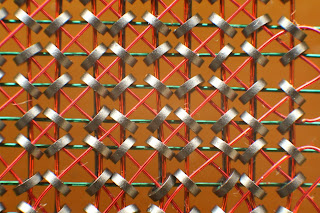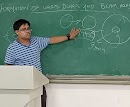Space Exploration
America’s ‘MOON’ rocket’s old school but amazingly effective ‘BRAIN’!!!
“That’s one small
step for a man, one giant leap for mankind”…. This was the famous line spoken
by the legendary American astronaut Neil Armstrong when he stood on the moon
for the first time.
Certainly, it was
a big step and a giant leap but, do you know that the engineering of the
engineers and the hard work of the scientists for this mammoth project were
much bigger and influential than the whole event???
Saturn V, the rocket used in Apollo 11 (first man mission to the moon) is the most powerful and the tallest rocket ever built by human civilisation and one shouldn’t get surprised
if I say that the amount of engineering and the number of hours spent on the development
of this mammoth is directly proportionate its overwhelming appearance and
power.
But, even the most
gigantic machines will not work without a ‘brain’ and Saturn V was no exception.
This article focusing on the amazing 60’s tech used to build an old school but
effective brain system for this rocket.
 |
| Saturn V: Apollo 11 launch |
Analysis of Core the architecture of Saturn’s Brain:
 |
| The module of Saturn's LVDC (source: Smithsonian Institution) |
Saturn Launch Vehicle Digital Computer (LVDC) was the name given to Saturn’s Brain. It provided the autopilot for the Saturn V rocket from the launch to the insertion in Earth’s orbit. It was developed by IBM’s Electronics Systems Center.
LVDC was capable
of executing 12190 instructions per second. Comparing with a modern i9 processor
which can execute about 12-13 billion instruction per second, about 1 million
times faster!!!
For better reliability,
LVDC used triple-redundant logic and a voting system. In layman way, triple-redundant
logic is a system where three different systems perform a process and the result
is decided by a majority-voting system and can produce a single output.
LVDC was
approximately 30 inches wide, 12.5 inches high and weighed around 80 pounds.
The chassis which was made of magnesium-lithium alloy LA 141, had high stiffness,
low weight and good vibration damping properties. The alloy LA 141 was also
used by IBM for the construction of Gemini Keyboard and computer in very
small quantities.
The cooling system
used in this was also unique at that time. To construct an efficient cooling
system, the chassis was divided into a 3 x 5 matrix of cells which all are separated
by walls. Through these walls, the coolant was circulated so that it can remove
138-watt power dissipated by the computer.
Analysis of Saturn’s
Memory Module (in brief):
But, a ‘Brain’ is
incomplete without a memory system and that’s why ‘Saturn’s Brain’ was equipped
with an amazing memory system which was unique at that time. Like most
computers at that time, it used core memory and stored data in tiny magnetic
cores. Memory was in the form of 13-bit syllables and its master clock ran at
2.048 MHz. Since it has four memory module so, it gave a total capacity of
16,384 words. Each memory module can store 4096 words of 26 bits.
 |
| Cores inside the memory module (source: UX collective) |
Core memory was built from tiny ferrite rings which are called as cores. Each core can store a bit by magnetising it either clockwise or anti-clockwise. For the magnetisation process, a pulse of current through the wires threaded through the core and the magnetisation can be reversed by sending a pulse in the opposite direction.
Not only this, the
amazing scientists of NASA and IBM found out a very innovative way to determine
the value of the core. A current pulse flipped the core to the 0 state. If the core
was in 1 state previously, then the changing magnetic field created a voltage
which was sensed by a wire threaded through the cores. And if the core was already
in 0 state, then the magnetic field wouldn’t change and thus voltage wasn’t detected
by the wire. Quite a simple right…???
But, with this
process…a totally new challenge was also created. The challenge was that the
process of reading a core destroyed its value, so it needed to be re-written. So, scientists develop a unique solution to tackle this problem. They noted that
a small current has no effect on a core, but a current above a threshold can
magnetize the core. So, by using this principle, they created a grid of X and Y
lines to select one core from the grid and by energizing one X line and one Y
line each with half the necessary current, only the core where both the lines
crossed would get enough current to change its value and the other cores remain
unaffected. Brilliant….right???
To know basics of the quantum world, astronomy and space exploration you can check out my book "Through the wormhole" on amazon kindle.
Thanks for Reading!!!
Check out my other blog posts!!!
Don't forget to share this post in your social media handles to enrich everyone's knowledge!!!
You can directly talk with me on Instagram
To meet more physics Enthusiasts please join our Facebook Page
Also for the latest updates of my posts join me on Twitter
See you Again!!!!!
-Ratnadeep Das Choudhury
Founder and writer of The Dynamic Frequency












0 Comments